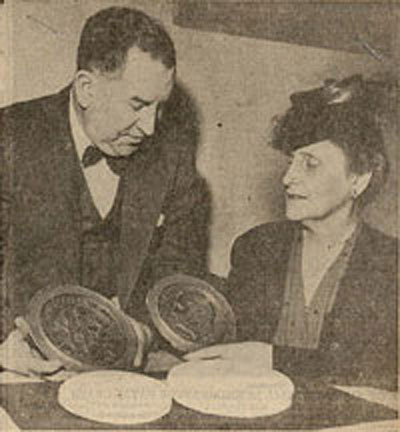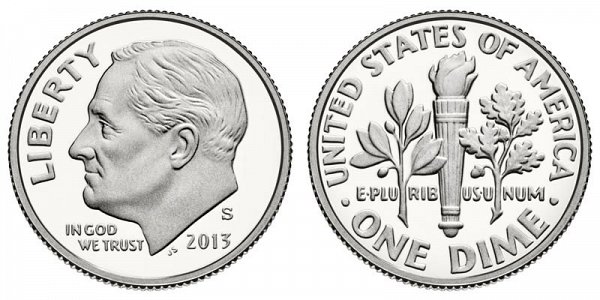John R. Sinnock
US Chief Coin Designer and Engraver - Roosevelt Dime and Franklin Half Dollar
John Ray Sinnock was born on July 8, 1888 in the city of Raton, New Mexico. Sinnock is most famously known for serving as the eighth Chief Engraver at the US Mint. At an early age, he was interested in the arts and had a knack for sculpting and other various forms of art. As he grew up, John became more talented and serious about his work, which would later become is career. Eventually he moved to Pennsylvania and attended the Philadelphia Museum School of Industrial Art and studied artistic methods and designs. In 1913 at the age of 25, he finally earned a degree in Normal Art Instruction. Nowadays, this school is known as the University of the Arts College of Art and Design.
When John Sinnock graduated from college, he started to slowly build up his name and reputation by playing an active role in local art community. One commitment that he made was becoming a member of the Philadelphia Sketch Club and also the Philadelphia Alliance. There, he met up with other artists and also showed off his own works. In fact, he had produced a number of portrait medals while attending the Pennsylvania Academy, another art institution that Sinnock attended. He later put these medals on display for the public and fellow artists to view his exhibits. Some of the portraits and medals included famous people such as US President Herbert Hoover, inventor Thomas Edison, writer Charles Dickens and Henry Morgenthau.
As his reputation was increasing, he was able to successfully land a job teaching as an instructor of the arts at the same school he graduated from and also at the Western Resesrve University. John taught at Western Reserve University for about 10 years. At one point, the US Mint was looking to hire an assistant sculptor, and so Sinnock applied for the position and was quickly hired by the Mint's Chief Engraver George T. Morgan. In 1923, John R. Sinnock became Assistant Chief Engraver at the US Mint.
One of Sinnock's first works designing coins at the Mint was a collaboration project with George Morgan. Sinnock designed the reverse of the commemorative 1918 Illinois Centennial Half Dollar while Morgan designed the obverse of the coin, which depicted US President Abraham Lincoln. Not long afterwards, George T. Morgan passed away and John R. Sinnock took over his post and became the eighth Chief Engraver of the US Mint in 1925.
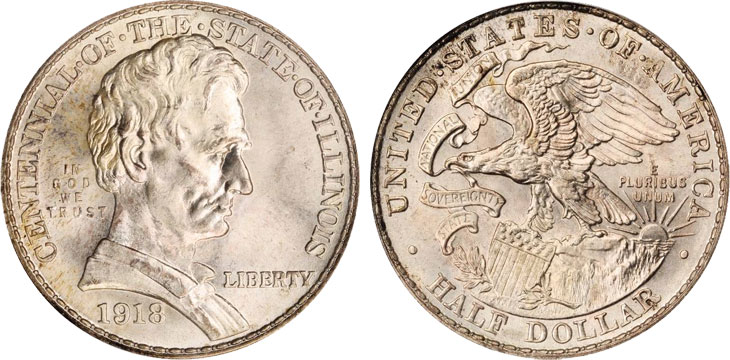
The 1918 Lincoln Illinois Centennial Silver Half Dollar. Obverse designed by George T. Morgan, Reverse designed by John R. Sinnock.
Only a year after becoming Chief Engraver, Sinnock engraved the 1926 Sesquicentennial American Independence Half Dollar for the 150th anniversary of the signing of America's independence. This coin was to be designed for the Sesquicentennial International Exposition in Philadelphia on July 4, 1926. The front of the coin featured both President Washington and President Calvin Coolidge, who was the current president at that time. At the time, it was highly unusual that a living president be used as a portrait on the coin. The reverse featured the Liberty Bell, which is a precursor for a future official US coin that Sinnock would help design later. Sinnock originally designed the coin, but his final designs were very unpopular. Instead, the designs by John Frederick Lewis would be the ones used for this commemorative coin. All Sinnock did was take the design sketches and convert them into the three dimensional models, which would be used to engrave the coin with. Even though Sinnock didn't design the coin, he took the full credit. About 1,000,000 were produced but over 850,000 were melted down later on.
John Sinnock also designed the 1926 Sesquicentennial American Independence Gold $2.50 Quarter Eagle coin as well. The obverse featured a standing liberty while the reverse featured the Independence Hall building located in Philadelphia, Pennsylvania, where the Declaration of Independence and US Constitution were signed. It is also the location of the Liberty Bell. Again, this was another US commemorative coin where only 200,000 were produced, but over 150,000 were melted down again a short time later. Unfortunately, none were issued at the Exposition that year.
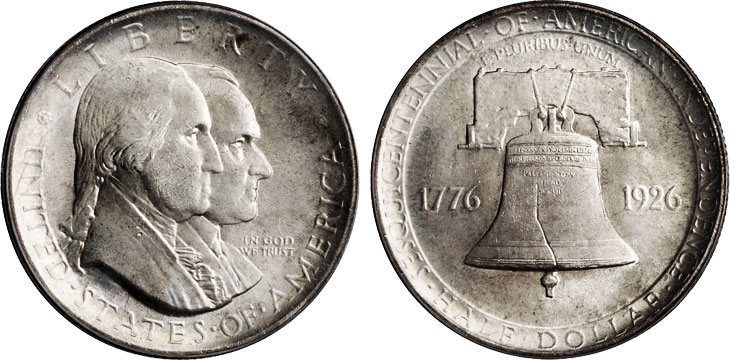
The Commemorative 1926 Sesquicentennial American Independence Silver Half Dollar. Designed by John Frederick Lewis - Sculpted, modeled and engraved by John R. Sinnock.
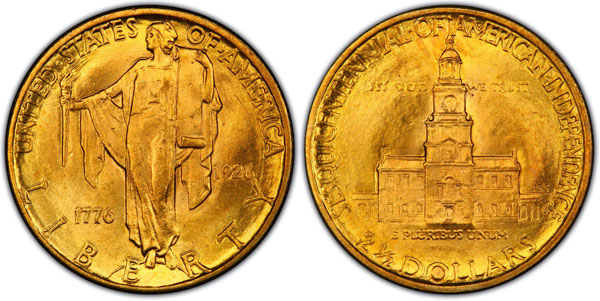
The Commemorative 1926 Sesquicentennial American Independence $2.50 Gold Quarter Eagle. Designed by John R. Sinnock.
A few years later, John Sinnock was involved in the creation of the Purple Heart military medal, a prestigious award that would be given to those who were wounded or killed while serving in the military, starting on April 5, 1917. Originally, this badge was invented by General George Washington and was called the Badge of Military Merit and consisted of a purple clothed shaped like a heart and lined with lace. There was a call to resurrect this award again and a bill was proposed to Congress.
On January 7, 1932, General Douglas MacArthur boldly reopened work on the revival of this award and worked with the Washington Commission of Fine Art. An Army Heraldic Specialist from the Office of the Quartermaster General by the name of Elizabeth Will was in charge of the redesign. The Commission chose three prominent sculptors, including John R. Sinnock, to sculpt the plaster models for Will's medal design. In the end, John R. Sinnock was selected as the winning sculptor. The medal was officially revived by Executive Order of the President of the United States on February 22, 1932, which was the bicentennial or 200th anniversary of George Washington's birth. Elizabeth Will takes the credit for the design of the Purple Heart medal and John Sinnock takes credit for making refinements and the modeling of the medal.

Purple Heart Medal - Badge of Military Merit, designed by Elizabeth Will, modeled and refined by John R. Sinnock
During the early to mid 1940s, the United States was battling the Great Depression and World War II. At the time, the nation and the "Greatest Generation" was being led by US President Franklin Delano Roosevelt. Roosevelt passed away on April 12, 1945, near the end of World War II. Nellie Tayloe Ross, the current US Mint Director, immediately began plans to commemorate President Roosevelt. Roosevelt, who was a victim of Polio, passionately founded and participated in the March of Dimes, which was a campaign to fight and ultimately eradicate Polio. Nowadays, it promotes the general health of women and babies. Because Roosevelt was actively involved in the March of Dimes, it only seemed appropriate that the US dime be used to commemorate Franklin Roosevelt, and this is why his face was used on the dime.
Nellie Ross chose John Sinnock to design the new dime since he had already produced a medal depicting Roosevelt in the past. Based on his medal, he produced what is now known as the Roosevelt Dime. The front of the coin depicts Roosevelt facing left and the reverse of the coin depicts a flaming torch symbolizing liberty, with an olive branch symbolizing peace and an oak branch symbolizing victory. On January 30, 1946, the Roosevelt Dime was released to the public on what would be Franklin Roosevelt's 64th birthday.
Upon release of the new silver dime, there were false rumors and urban legend being spread around that the "JS" on the base of the Roosevelt busts on the dime actually stood for the initials "Joseph Stalin" and that a Soviet agent at the mint put this on the coin. This was around the same time period of the Second Red Scare when there was a strong anti-communist sentiment within the US. The Mint quickly denied this and re-affirmed that the "JS" initials on the coin are simply the initials of John Sinnock, who designed the coin.
During the same year in 1946, US Mint Director Ross gave Sinnock a new commission to produce a new design for the US Half Dollar. The required theme for the new coin was to honor Benjamin Franklin. Sinnock based the obverse of the coin on a 1933 Ben Franklin medal that he had produced earlier. He was successful in completing the obverse of the coin. However, John Sinnock passed away on May 14, 1947 at a young age of 59 before he could finish the reverse of the coin. The coin was completed by Gilroy Roberts, who took over the post and became the ninth Chief Engraver of the US Mint. Gilroy used the Liberty Bell as the reverse of the coin, which is very similar to the reverse of Sinnocks 1926 commemorative Sesquicentennial half dollar.
In 1948, this new silver coin was first produced and became known as the Franklin Half Dollar. It was released to the public on April 30, 1948, which was the anniversary date of President Washington's inauguration as US President. The coin would be produced up until 1963 when US President John F. Kennedy was assassinated and would be honored on the half dollar.

Medal of Benjamin Franklin, which the Franklin Half Dollar is based upon. Medal designed by John Sinnock in 1933.
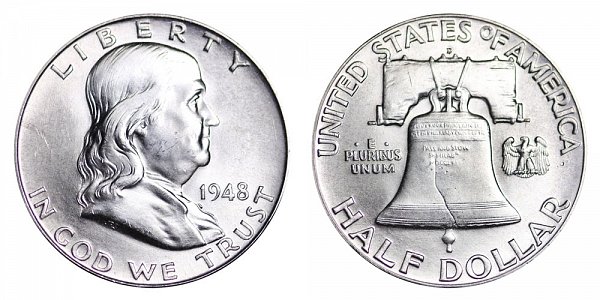
Benjamin Franklin Silver Half Dollar, obverse designed by John R. Sinnock, reverse designed by Gilroy Roberts.
The Roosevelt dime originally started with a silver metal composition in 1946. This was changed in 1965 when President Lyndon Johnson passed the Coinage Act of 1965. Due to the shortage of silver and the increasing value of silver metal in coins, people began hoarding all silver coins because their intrinsic metal value of precious silver was worth more than the face value of the coins. So the metal composition was changed to 91.67% copper and 8.33% nickel. Although, John Sinnock's Roosevelt design remained unchanged up until the present date.
John Sinnock would be remembered as one of the greatest coin engravers around. He had also won many other awards, including the A.W. Mifflin Award given for study abroad. John also produced a Congressional gold medal that would be awarded to Thomas Edison, among many other commemorative medals and coins that he had produced. After Sinnock passed away, much of his work and materials in art were given to Margaret Campbell, a trusted friend of his. Some of his work is now part of a collection at the Luxembourg Museum in Paris, The American Numismatic Society of New York and the National Museum in Washington DC.
